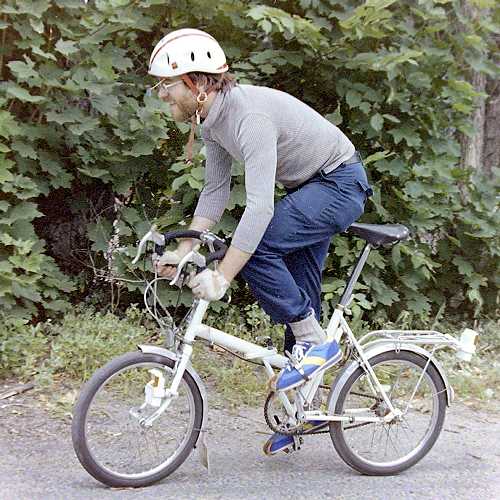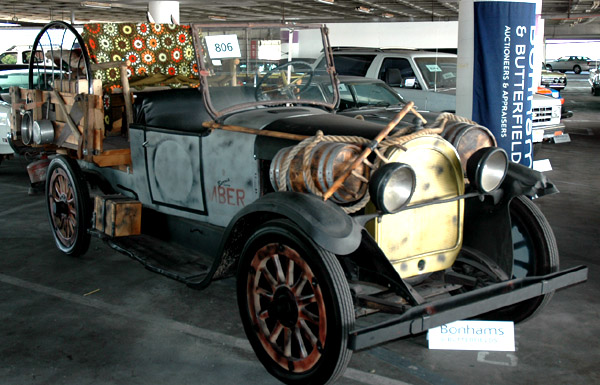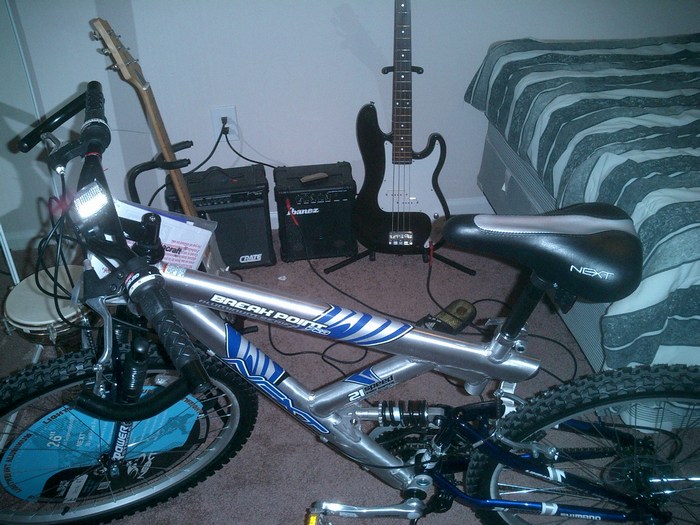If you bike frequently, or even just live in a major city, I suspect that you have at some point encountered a folding bicycle. (The fact that you have found your way to this blog also supports this theory, but then again, you may just have time on your hands and I am not one to judge.) I am also willing to bet that you had one of three reactions this first time you saw a folding bike:
1) That . . . is . . . the coolest thing . . . I have ever seen . . . I . . . must have one. (If this is you, then you may not need to read this post)
2) What the hell is that, and why doesn't this strange person have a normal bicycle? Don't they have to pedal more? I should probably keep an eye on them as they may do something else crazy.
3) Ughhhh . . . why is someone bringing a hunk of metal into this store/on the subway/etc? Can't they just drive a car or lock it outside like everyone else?
This is for those of you that fall into the last two categories as well as those of you that have some interest in a folding bike or other alternative forms of transportation, but still have questions and concerns about their practicality. For the time being, I won't go into the modicum of benefits of bicycling and especially of using the bicycle as a means of transportation -- suffice it to say that many of us weigh more than we want to, probably drive a lot and spend a lot of time sitting in traffic, and at least a few of us have concerns about the long term environmental impact of carbon fueled vehicles. Riding a bicycle contributes to resolving all of these issues.
Why not a regular bicycle? Well, in many cases, why not. Personally, I would generally prefer to ride a full size, non-folding bicycle in most situations. The inherent suspension of larger wheels offers a more comfortable ride, the lack on hinges for folding offer a lower weight, and in many cases also offer a more rigid frame, and frankly, a full size bicycle just looks . . . well, better to most eyes.
Case in Point:


However, the reality of the situation is that in a lot of cases, a traditional bicycle is far from ideal. Lets consider a few of them:
1) Travel - whether you are flying halfway across the globe, or taking a short trip upstate, traditional bicycles are inherently bulky and difficult to travel with. If you want to fly you first have to either get a cardboard bike box from a store or spend hundreds of dollars on a case, neither of which will guarantee the safety of what for many people is a substantial investment. Then you have to get this giant box to the airport where you will likely have to pay between $80 and $100 each way for the privilege of lugging it on the plane; or you can pay $40 to hundreds of dollars each way to ship your box where you are going. Also, don't forget that you will have to a) find somewhere to ship it to, b) send it days ahead of time, and c) arrange to pick it up somehow once you have arrived. Sounds like fun, right.
As for driving, you are faced with getting an expensive roof mounted rack, an awkward trunk or hitch mounted model, or fold down the rear seats and jam the bike in the trunk. When you get to your destination, you now likely have the pleasure of riding a wet bike (rain), covered in bugs, and with much of the grease blown out of its seals, or you get to clean the blackest grease you can imagine off your automobile's luxurious interior. Oh, and don't forget that the bikes you strapped to your car eliminated the wind tunnel testing done in the last century and effectively made your car the aerodynamic equivalent of the Beverly Hillbillies sweet ride.

2) Storage - This is an especially important consideration for people that live in cities (like myself) where space is often at a premium It never feels good to know that your bicycle is taking up $200 rental space in your 500 sq. ft. apartment.

3) Theft Prevention - Like it or not, bicycle theft is a HUGE issue in many areas. As much fun as it is to ride your $5000 carbon steed, the 40lbs of locks needed to sort of secure it seem to negate most of the weight savings of that full Record groupo. Most people therefore end up with either an absolute piece of crap salvage job, or some sort of low end bicycle and the 40lbs of locks, with the knowledge that the bike will still inevitably be stolen or vandalized some day. Hopefully, that happens just as the bike has started to fall apart from being left outside all the time, and the fact that it was a lousy bike to begin with.
as it is to ride your $5000 carbon steed, the 40lbs of locks needed to sort of secure it seem to negate most of the weight savings of that full Record groupo. Most people therefore end up with either an absolute piece of crap salvage job, or some sort of low end bicycle and the 40lbs of locks, with the knowledge that the bike will still inevitably be stolen or vandalized some day. Hopefully, that happens just as the bike has started to fall apart from being left outside all the time, and the fact that it was a lousy bike to begin with.
************** SOLUTION - FOLDING BICYCLES **************
As I discussed earlier, folding bikes are not ideal in all situations, and they certainly have drawbacks relative to traditional cycles; they do however resolve issues that for many people make owning and riding a bike all but impossible. We'll discuss the drawbacks in a later post, but let's look at the folding bicycle in relation to each of the three issues mentioned above.
1) Travel - Many companies, Bike Friday is perhaps the best known, offer cycles that can be easily packed into a regulation sized suitcase. That means no giant bike box, no trip to the bike shop to get your bike taken apart and reassembled, no added fees at the airport or need to ship days ahead of your trip. As for weekend jaunts or trips with the car, a folding bike easily fits into a trunk (you can actually fit quite a few if you are traveling with a group). An additional benefit of this ease of transport is the ability to use multi modal transport. For many trips, especially for many who want to commute to work, the distance is to great as to be practical with a bicycle. However, there may be public transportation, be it a bus, train, ferry, etc. within a few miles of home and work. With a folding bike, you can easily ride to the train, get on without enduring the aggravation of other passengers at bringing a full size bike on during rush hour, and then get off and ride your bike the rest of the way to work having cut much of the distance out of the trip. As population has decentralized, this situation is an increasingly common one, and many people don't even realize that options outside of driving even exist.

2) Storage - This seems almost self obvious. Most folding bikes easily fit in a closet, behind a couch, or even on larger shelving units.

3) Theft Prevention - In many ways the same situation as storage -- folding bikes are easy to bring into essentially anywhere you may want to go (work, stores, restaurants, movie theaters, etc.) In places like my native NYC, theft is a preposterously large issue for would be cyclists to surmount. The peace of mind that comes from knowing that you're bike is in no danger of being stolen or vandalized is incredibly liberating. It allows you a great deal of flexibility in the type of trip you would make by bicycle, from going to dinner, to getting groceries, to seeing a movie at a theater miles from where you live.
***************** CONCLUSIONS *****************
Folding bikes may not be right for you, but I strongly encourage you to think more seriously about them before immediately dismissing them as many people do. They offer a number of benefits, especially to the city dweller, and can be an excellent compromise for many people unsatisfied with some of the drawbacks of a traditional bicycle (even you crazy recumbent riders out there -- folding recumbents do exist!)
In the next post I plan to look at the many unfounded criticisms of folding bikes (as well as some valid ones). From there we will see where this grows too. I hope to look at the wide variety of folding bikes available today and offer some of my thoughts on their individual merits. You can also expect periodic news and reviews of new products along with general thoughts on cycling outside of the folding world. Ultimately, I'd love to bring you interviews with some of the important players in the folding bike world, but I suspect that may be a ways off. Hopefully, you will enjoy the ride as I figure it all out.

 This basic concept is employed by a number of other folding bike manufacturers, perhaps most notably by Brompton. The Brompton design, developed by Andrew Ritchie in 1975 employs the rear suspension block in a rather ingenious fashion -- the entire rear triangle is free to swing under the bike when folding, or compress the rubber block while riding.
This basic concept is employed by a number of other folding bike manufacturers, perhaps most notably by Brompton. The Brompton design, developed by Andrew Ritchie in 1975 employs the rear suspension block in a rather ingenious fashion -- the entire rear triangle is free to swing under the bike when folding, or compress the rubber block while riding.
 The Brompton does not offer any front suspension out side of stem flex, which from my personal experience is minimal. One company though decided that through some clever design and user specific tuning of tube thicknesses that comfort could be achieved through stem and seat tube flex. Enter, Bike Friday:
The Brompton does not offer any front suspension out side of stem flex, which from my personal experience is minimal. One company though decided that through some clever design and user specific tuning of tube thicknesses that comfort could be achieved through stem and seat tube flex. Enter, Bike Friday: This particular model, the Air Friday employs a titanium suspension bean in lieu of a more traditional seat tube (as is used on most Bike Fridays) along with the custom "Goose Neck" stem that also provides some forgiveness while riding. Just in case this whole frame flex option seems insufficient to you, there is also the Pantour suspension hub. These special hubs offer up to 1 inch of self contained travel.
This particular model, the Air Friday employs a titanium suspension bean in lieu of a more traditional seat tube (as is used on most Bike Fridays) along with the custom "Goose Neck" stem that also provides some forgiveness while riding. Just in case this whole frame flex option seems insufficient to you, there is also the Pantour suspension hub. These special hubs offer up to 1 inch of self contained travel. They are a popular aftermarket upgrade for Brompton Bicycles and are perhaps most easily found on the Dahon Speed Pro, which ships with a suspension front hub.
They are a popular aftermarket upgrade for Brompton Bicycles and are perhaps most easily found on the Dahon Speed Pro, which ships with a suspension front hub. Dahon also takes a more simplistic approach to suspension in a number of its folding bikes, notably the Curve series -- larger volume tires. Though some of the rolling efficiency of high pressure, narrow tires is lost (as it would be with any balloon tired cruiser), the added comfort is appreciated. Furthermore, since speed loss is minimal, and these particular bikes are not intended for racing, balloon tires can be a cheap and effective way to overcome some of the drawbacks of small wheels.
Dahon also takes a more simplistic approach to suspension in a number of its folding bikes, notably the Curve series -- larger volume tires. Though some of the rolling efficiency of high pressure, narrow tires is lost (as it would be with any balloon tired cruiser), the added comfort is appreciated. Furthermore, since speed loss is minimal, and these particular bikes are not intended for racing, balloon tires can be a cheap and effective way to overcome some of the drawbacks of small wheels. In contrast to this approach, Alex Moulton further refined his popular design started in the early 1980's and most recently with the AM New Series. Aside from the obvious lattice work "Space Frame", these bicycles feature a more advanced fluid dampened rear suspension and a parallelogram suspension fork. This design was so impressive as to earn a spot in New York's Museum of Modern Art.
In contrast to this approach, Alex Moulton further refined his popular design started in the early 1980's and most recently with the AM New Series. Aside from the obvious lattice work "Space Frame", these bicycles feature a more advanced fluid dampened rear suspension and a parallelogram suspension fork. This design was so impressive as to earn a spot in New York's Museum of Modern Art. One last approach come from Riese & Muller's Birdy line and is in many ways a modification of the Moulton design. It is notable in that the front parallelogram suspension separates and is actually integral to folding the bicycle.
One last approach come from Riese & Muller's Birdy line and is in many ways a modification of the Moulton design. It is notable in that the front parallelogram suspension separates and is actually integral to folding the bicycle. I hope you enjoyed this tour of the wide variety of suspension mechanisms employed in the small wheeled world. The diversity of design found in small wheeled bicycles and folding bicycles in particular is one of the reasons for my continued interest in the subject, so I hope you found this cursory look enjoyable. Next time, I will look at some of less obvious advantages of small wheeled bicycles and talk a bit about my personal experiences riding them; in the mean time though, get up, and go ride.
I hope you enjoyed this tour of the wide variety of suspension mechanisms employed in the small wheeled world. The diversity of design found in small wheeled bicycles and folding bicycles in particular is one of the reasons for my continued interest in the subject, so I hope you found this cursory look enjoyable. Next time, I will look at some of less obvious advantages of small wheeled bicycles and talk a bit about my personal experiences riding them; in the mean time though, get up, and go ride.

















